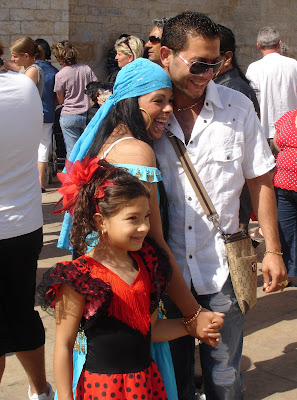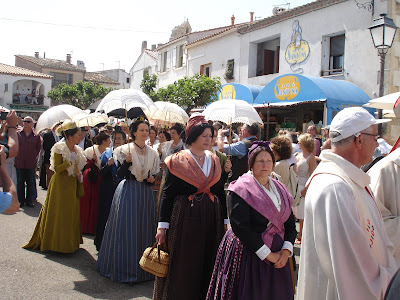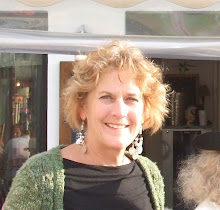

The Camargue is a special part of France where one can see wild white horses, flamingos and cowboys. It's a flat marshland south of Arles where rice is grown and salt is harvested from the sea.
We first visited the Carmargue last May when we went on a pilgrimage to Les Saintes Maries de la Mere to join gypsies from all over Europe for the celebration of Saint Sara, the patron saint of the gypsies. Unfortunately the wild winds, another feature of this area, blew our tent down and we headed home before the festivities began.
There are various versions of who the Maries were and the role of Sara, but the version I will describe comes from a pamphlet I purchased from Les Saintes Maries Brotherhood which began in the year 1315 with the aim of honoring and protecting the Saint Maries. This is their version, which I've abbreviated somewhat:
"Around the year 44 the saints and their companions were exiled and placed into a small boat without sail, oar, pilot, or food, so that they would drown and nobody would ever hear from them again. Of course the Lord protected them and delivered them to the wild and depraved place, La Camargue.
Martha and Marcell went to Tarascon, Lazarus and Maria Magdelena went to Marseille, Maximin and Sidoine to Aix-en Provence.
The two Saint Maries and their servant, Sara, stayed where they landed, erecting a small chapel and evangelized the pagan tribes. Saint Marie Jacob was the mother of James the minor and Jose, and probably of the apostles Jude and Simon too. Saint Marie Salome was the mother of the apostles James and John.

Sara's mystery
Either she came with the saints in the boat or became their devoted servant after their arrival.
Actually nobody knows who Sara is, or how her worship began in Les Saintes Maries. Sara is an enigma to histeriography, which does not seem to be on the point of being solved. To the gypsies who do not wonder so much, she is the Saint they pray to and acclaim.
Sara served the Maries and lived close to them in an atmosphere of saintliness. Their fame expanded and people came to them to seek appeasement and comfort. They died in the odour of sanctity, one after the other, months apart. With Sara's help, they were buried one next to the other under the Oratory Alter. The crowd of first christians they converted immediately rushed from all over to pay them tribute. That is how the pilgramages started and continue to today. Sara died a few years later and was buried with the Maries."

Here I am standing next to the most famous gypsy guitarist alive, Manitas de Plata. He is 85 years old and we had the honor of hearing him play.
His name means: Silver hands
Gypsies come from all over Europe for this annual event. Priests, monks, nuns and laymen who are in touch with the Gypsies all year long, meet during the days before the pilgmage to greet them, pray with them and prepare them for the sacraments. There are only a hand full of old wagons, mostly for display. Most gypsies travel in late model white vans.







The pilgimage consumates with a procession to the sea when thousands of people line the streets and the beach to watch white horses accompany the gypsies who carry an effigy of Sara to the sea.
That is Jim in the blue shirt and hat, standing waste deep in the sea with the gypsies, the horses and Sara.

When the horses headed back up the beach the people in front of me backed away and I was left standing on the front line as the procession of horses plowed threw crowd. It was scary and thrilling.

The next day there was a second procession to the sea. This time it was the Brotherhood and towns people carrying the two Saint Maries. Many the gypsies had packed up and gone on. The crowd was smaller and made up of a strange mix of gypsies, cowboys, people from the brotherhood dressed in turn of the century clothing, and the rest of us.







The day following the procession for the Maries, the cowboys ran a couple bulls through the streets of Les Saints Maries de la Mere to the bull ring.



If you've enjoyed my blog, I'd love to hear from you.
You can click on the link below to add a comment.


